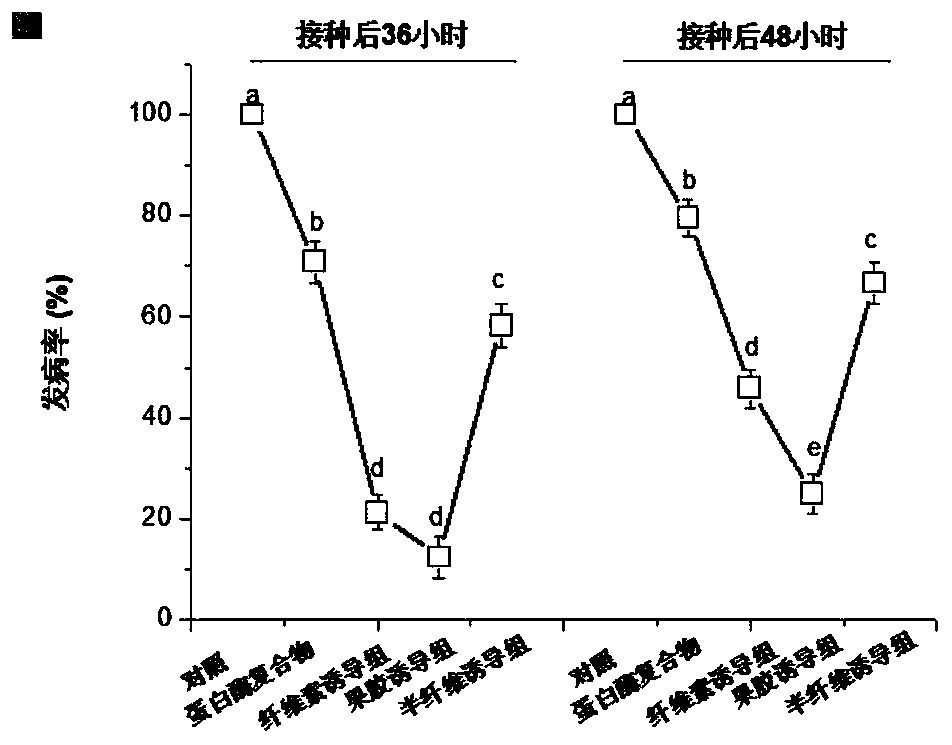Oligosaccharide preservative for inhibiting fruit softening and reducing mechanical damage harm, and use method and purpose thereof
A technology of mechanical damage and antistaling agent, applied in the field of freshness preservation, can solve the problems of low dry matter content, low sugar and acid, poor taste, etc., and achieve the effects of good reaction repeatability, simple product separation and purification process, and easy acquisition
- Summary
- Abstract
- Description
- Claims
- Application Information
AI Technical Summary
Problems solved by technology
Method used
Image
Examples
Embodiment 1
[0074] Example 1: Preparation and application of apple pomace-derived plant cell wall polysaccharide enzymatically hydrolyzed oligosaccharide complex
[0075] A. Utilizing apple pomace waste to prepare preservatives for promoting fruit mechanical injury healing
[0076] A preservative for promoting fruit mechanical injury healing was prepared by enzymatic hydrolysis and alcohol precipitation. After hydrolyzing 50mL of apple pomace (0.5%-10%w / v) with 10mL of microbial polysaccharide hydrolase complex (water bath, 37°C), add 1-5 times the volume of 95% ethanol, and place it overnight at 4°C. Centrifuge at 4000-9000 g for 20 minutes (4° C.), and collect the supernatant. The supernatant was distilled and rotated at 60°C and 20r / min until it was spin-dried or concentrated by vacuum freezing, and finally dissolved the precipitate with deionized water to obtain the target preservative, and the concentration of the product was not lower than 4% (w / v) . The target product was dete...
Embodiment 2
[0085] Embodiment 2: fruit physiology experiment
[0086] a. Fruit mechanical damage healing preservative slows down the decline rate of postharvest tomato (S.lycopersicum) fruit firmness Rate
[0087] A small piece of cylindrical tomato tissue was drilled with a sterile drill to create a wound on the surface of the tomato with a depth of 2 mm and a diameter of 5 mm. There are several tomatoes, one hole is punched for each tomato, and 48 hours is marked on the top of the hole, 50 μL of the oligosaccharide preservative of the present invention is added, wrapped with a plastic wrap, and put into an incubator. After 0, 2, 4, and 6 days, the fruit firmness was measured with a hand-held hardness meter. At each time period, each group took out two tomatoes for hardness measurement.
[0088] The result is as Figure 4 as shown, Figure 4 It shows the change of tomato fruit firmness after 2, 4 and 6 days of induction. The oligosaccharide preservative treatment group can obviou...
Embodiment 3
[0095] Embodiment 3: Postharvest pathology and fruit physiological and biochemical experiments
[0096] A. Fruit Mechanical Damage Healing Preservative Promotes Self-healing of Tomato (S.lycopersicum) Fruit Wounds
[0097] The wound-healing capacity of tomato fruit was expressed by the incidence of postharvest pathology at the wound site of tomato fruit.
[0098] A small piece of cylindrical tomato tissue was drilled with a sterile drill to create a wound on the surface of the tomato with a depth of 2 mm and a diameter of 5 mm. There are several tomatoes, one hole is punched for each tomato, and 48 hours is marked on the top of the hole, 50 μL of the oligosaccharide preservative of the present invention is added, wrapped with a plastic wrap, and put into an incubator. After 24 hours, take out the tomatoes, punch a hole for each tomato, mark 24 hours above the hole, add 50 μL of the oligosaccharide preservative of the present invention, seal it with a plastic wrap and put it...
PUM
 Login to View More
Login to View More Abstract
Description
Claims
Application Information
 Login to View More
Login to View More - R&D
- Intellectual Property
- Life Sciences
- Materials
- Tech Scout
- Unparalleled Data Quality
- Higher Quality Content
- 60% Fewer Hallucinations
Browse by: Latest US Patents, China's latest patents, Technical Efficacy Thesaurus, Application Domain, Technology Topic, Popular Technical Reports.
© 2025 PatSnap. All rights reserved.Legal|Privacy policy|Modern Slavery Act Transparency Statement|Sitemap|About US| Contact US: help@patsnap.com



